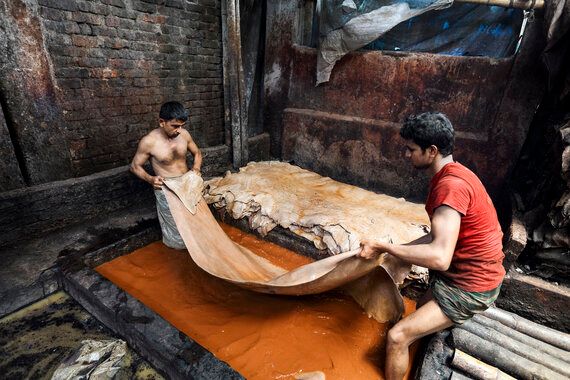
You might be mistaken for thinking the worst side effect of a pair of killer heels is the odd blister after a night of dancing. However lung cancer, blindness, asthma, skin ulcers, nose bleeds, fevers, headaches, and eczema are just some of the side effects that workers producing a killer pair of leather heels can suffer.
Shoe production is a shady world. There is little to no transparency throughout the shoe industry, and complex global supply chains make it nearly impossible to pick up a shoe in a high street store and trace its origins. Even a shoe labelled 'Made in Italy', for example, can rarely be guaranteed. Often leather tanned in Asia is transported to Europe for assembly, and your 'Made in Italy' shoe could be almost entirely assembled in Romania.
The UK is one of the world's largest consumers of shoes, with each person buying an average of five new pairs of shoes per year. Many of these originate in Asia. India, for example, is the second largest producer of shoes globally after China with over one million people involved in the Indian shoe industry. Of this industry leather shoes are by far the most important element, and the UK is one of the main importers of Indian leather footwear.
Shoe supply chains are multi-layered. Brands often employ agents to source factories, who then subcontract work out to other factories or homeworkers. The lack of transparency removes brands from a direct relationship with the dangerous workings of tanneries in India and Bangladesh, however it doesn't make them any less culpable.

Photo credits: GMB Akash
The human and environmental impacts of leather shoe production can be deadly. Tanning, the process of transforming animal skins into leather, is usually done using chromium salts. This process, when properly managed and regulated, does not necessarily pose a threat, however tanneries across Asia operate with little concern for their workers safety. In such cases, chromium III, a relatively harmless element used in tanning leather, oxidises and turns into chromium VI, or hexavalent chromium, a severely toxic substance that is highly allergenic and carcinogenic.
Tannery workers are often not given any training in how to safely handle the chemicals nor any protective clothing to wear, wading with bare skin into vats of toxic chemicals. There are often no medical treatment areas on site, even for large tanneries where over a thousand people work. Many workers also sleep on the tannery floor, unable to escape the fumes even whilst they dream. A study of tannery workers in the Southern Indian state of Tamil Nadu estimates that 40% have health problems as a direct result of the chemicals they are handling. Widespread corruption means that Indian laws protecting workers are wilfully ignored.
Not only are these tanning chemicals harmful to the workers, but dangerous waste is not being disposed of safely, instead it is pumped into rivers and water supplies, seeps into soil and quickly finds its way into the food chain. Alongside the health risks, this also means even fewer options for people seeking alternative work, as agricultural land which was once rich and fertile is now heavily polluted.
These are industry-wide issues. Tanneries in Asia supply leather across the footwear spectrum, for luxury as well as fast fashion brands. If you're wearing leather shoes right now there's a high chance that someone handling the leather at some point in your shoe's journey will have suffered.
There is clearly an urgent need for reform, which is why Labour Behind the Label, and the Change Your Shoes campaign, is calling for greater transparency. We want UK brands to publish their supply lists, to report on progress in terms of moving away from dangerous chemicals, and to ensure a living wage and safe working conditions for all their workers.
Some brands, such as Clarks, have willingly engaged with us and agreed to
publish their supplier list within the next few months. This is a positive step, indicating that brands are willing to be held accountable for conditions in their supply chains.
Other brands, including high-end Harvey Nichols, high street brands Office and Schuh, and online fast fashion retailer Boohoo, have either not replied or provided a very limited response, giving little detail on definite steps they are taking to improve transparency and protect workers rights. Their silence raises questions over the level of human rights abuses hiding in their supply chains.
Please add your name to our petition demanding greater transparency in shoe production. Ask brands where they source their shoes from. Question how they guarantee the human rights of all their workers are upheld. No-one should have to go to work in conditions that will cause them harm. No-one should risk their life to make shoes.
Please take this first step towards ensuring a fairer shoe industry.
Together, let's put an end to killer heels.